Nursing Assignment: Healthcare Policies, Research, and Evidence
VerifiedAdded on 2023/01/18
|8
|1584
|26
Homework Assignment
AI Summary
This nursing assignment delves into the essentials of nursing research and healthcare policies, specifically focusing on the Affordable Care Act (ACA) and Medicaid. The assignment begins by differentiating between internal and external evidence, emphasizing their roles in evidence-based nursing care and quality improvement within clinical settings. Internal evidence, derived from nurses' experiences and observations, is contrasted with external evidence, which includes research findings and established guidelines. The assignment then examines potential changes to the ACA, proposing mandatory patient assessments and the employment of nurses from diverse ethnic communities to address patient needs and improve care quality. Furthermore, it provides a comparative analysis of the ACA and Medicaid, highlighting their similarities and differences as national health insurance programs. The assignment concludes with a discussion of the impact of these policies on nursing practice and patient care, supported by relevant references.
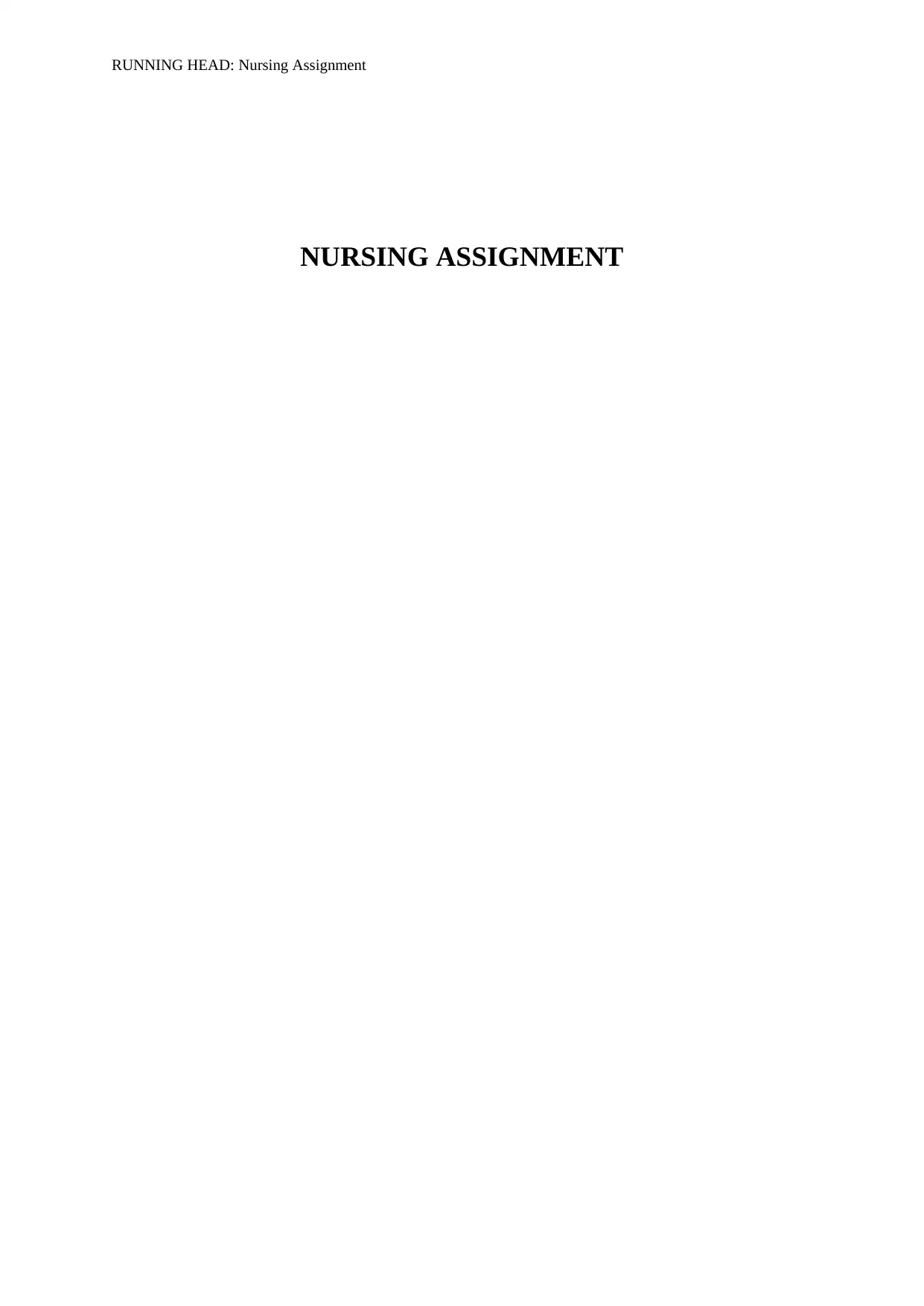
RUNNING HEAD: Nursing Assignment
NURSING ASSIGNMENT
NURSING ASSIGNMENT
Paraphrase This Document
Need a fresh take? Get an instant paraphrase of this document with our AI Paraphraser
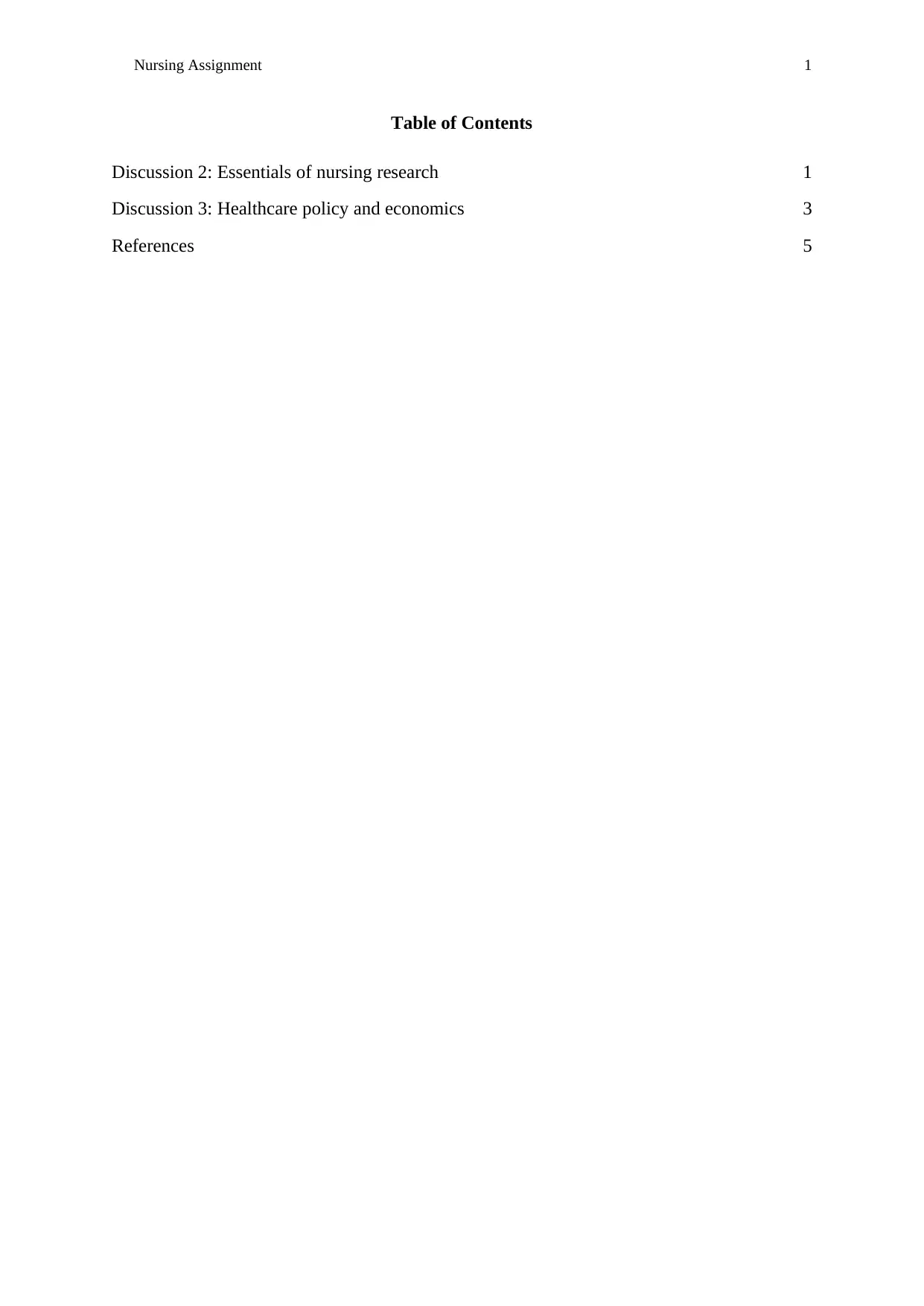
Nursing Assignment 1
Table of Contents
Discussion 2: Essentials of nursing research 1
Discussion 3: Healthcare policy and economics 3
References 5
Table of Contents
Discussion 2: Essentials of nursing research 1
Discussion 3: Healthcare policy and economics 3
References 5
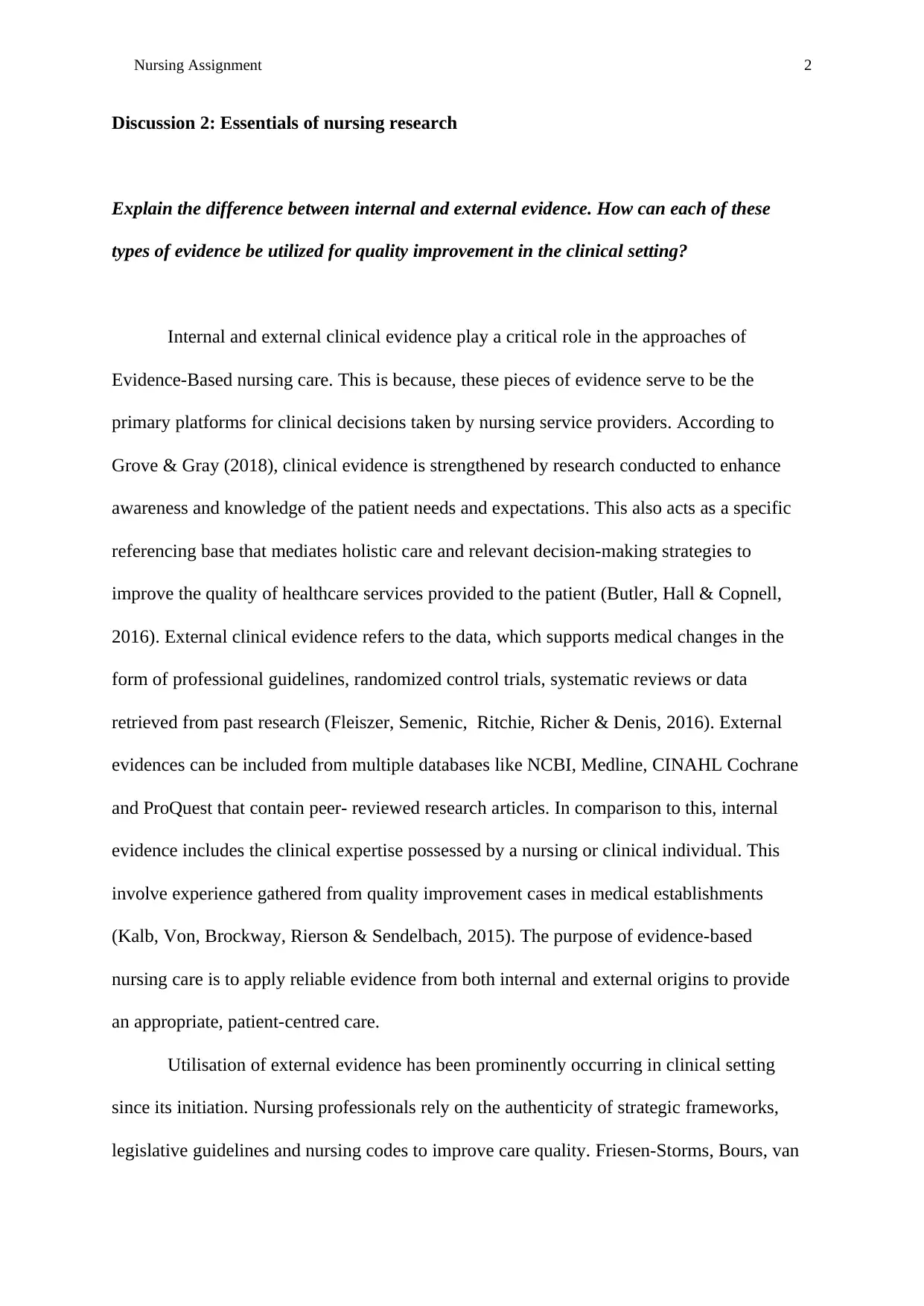
Nursing Assignment 2
Discussion 2: Essentials of nursing research
Explain the difference between internal and external evidence. How can each of these
types of evidence be utilized for quality improvement in the clinical setting?
Internal and external clinical evidence play a critical role in the approaches of
Evidence-Based nursing care. This is because, these pieces of evidence serve to be the
primary platforms for clinical decisions taken by nursing service providers. According to
Grove & Gray (2018), clinical evidence is strengthened by research conducted to enhance
awareness and knowledge of the patient needs and expectations. This also acts as a specific
referencing base that mediates holistic care and relevant decision-making strategies to
improve the quality of healthcare services provided to the patient (Butler, Hall & Copnell,
2016). External clinical evidence refers to the data, which supports medical changes in the
form of professional guidelines, randomized control trials, systematic reviews or data
retrieved from past research (Fleiszer, Semenic, Ritchie, Richer & Denis, 2016). External
evidences can be included from multiple databases like NCBI, Medline, CINAHL Cochrane
and ProQuest that contain peer- reviewed research articles. In comparison to this, internal
evidence includes the clinical expertise possessed by a nursing or clinical individual. This
involve experience gathered from quality improvement cases in medical establishments
(Kalb, Von, Brockway, Rierson & Sendelbach, 2015). The purpose of evidence-based
nursing care is to apply reliable evidence from both internal and external origins to provide
an appropriate, patient-centred care.
Utilisation of external evidence has been prominently occurring in clinical setting
since its initiation. Nursing professionals rely on the authenticity of strategic frameworks,
legislative guidelines and nursing codes to improve care quality. Friesen-Storms, Bours, van
Discussion 2: Essentials of nursing research
Explain the difference between internal and external evidence. How can each of these
types of evidence be utilized for quality improvement in the clinical setting?
Internal and external clinical evidence play a critical role in the approaches of
Evidence-Based nursing care. This is because, these pieces of evidence serve to be the
primary platforms for clinical decisions taken by nursing service providers. According to
Grove & Gray (2018), clinical evidence is strengthened by research conducted to enhance
awareness and knowledge of the patient needs and expectations. This also acts as a specific
referencing base that mediates holistic care and relevant decision-making strategies to
improve the quality of healthcare services provided to the patient (Butler, Hall & Copnell,
2016). External clinical evidence refers to the data, which supports medical changes in the
form of professional guidelines, randomized control trials, systematic reviews or data
retrieved from past research (Fleiszer, Semenic, Ritchie, Richer & Denis, 2016). External
evidences can be included from multiple databases like NCBI, Medline, CINAHL Cochrane
and ProQuest that contain peer- reviewed research articles. In comparison to this, internal
evidence includes the clinical expertise possessed by a nursing or clinical individual. This
involve experience gathered from quality improvement cases in medical establishments
(Kalb, Von, Brockway, Rierson & Sendelbach, 2015). The purpose of evidence-based
nursing care is to apply reliable evidence from both internal and external origins to provide
an appropriate, patient-centred care.
Utilisation of external evidence has been prominently occurring in clinical setting
since its initiation. Nursing professionals rely on the authenticity of strategic frameworks,
legislative guidelines and nursing codes to improve care quality. Friesen-Storms, Bours, van
⊘ This is a preview!⊘
Do you want full access?
Subscribe today to unlock all pages.

Trusted by 1+ million students worldwide

Nursing Assignment 3
der Weijden, & Beurskens (2015) comment these evidence set up a benchmark for the quality
and behaviour to be attained while caring for patients in a healthcare organisation. Journals,
articles and news provide comparative analysis of the pieces of evidence for the nurses to
choose as per their skill sets. Grove & Gray (2018) argue that internal evidence forms the
preliminary platform for clinical expertise while caring for diverse groups of patients. Nurses
can utilise internal evidence from their own experience, observations and reflections to set
personal indicators for holistic care services. The internal evidence approach use updated
systems for caregiving that are personally selected by nurses through systematic appraisals of
past events (Butler et al. 2016). Approaches for external evidence contain statistically
significant outcomes from published literature to formulate health and safety guidelines for
patients. According to Fleiszer et al. (2016), another significant contrast between internal and
external evidence is the process involved in collection, appraisal, interpretation and
incorporation. Thus, to provide quality care in an healthcare establishment, nurses must
utilise both internal and external evidence.
der Weijden, & Beurskens (2015) comment these evidence set up a benchmark for the quality
and behaviour to be attained while caring for patients in a healthcare organisation. Journals,
articles and news provide comparative analysis of the pieces of evidence for the nurses to
choose as per their skill sets. Grove & Gray (2018) argue that internal evidence forms the
preliminary platform for clinical expertise while caring for diverse groups of patients. Nurses
can utilise internal evidence from their own experience, observations and reflections to set
personal indicators for holistic care services. The internal evidence approach use updated
systems for caregiving that are personally selected by nurses through systematic appraisals of
past events (Butler et al. 2016). Approaches for external evidence contain statistically
significant outcomes from published literature to formulate health and safety guidelines for
patients. According to Fleiszer et al. (2016), another significant contrast between internal and
external evidence is the process involved in collection, appraisal, interpretation and
incorporation. Thus, to provide quality care in an healthcare establishment, nurses must
utilise both internal and external evidence.
Paraphrase This Document
Need a fresh take? Get an instant paraphrase of this document with our AI Paraphraser

Nursing Assignment 4
Discussion 3: Healthcare policy and economics
Based on your readings this week; if you were given the opportunity, what changes would
you make to the ACA, and why?
Affordable Care Act (ACA) or Obamacare has created significant impact on
healthcare industry in terms of inexpensive provisions and employment. However, it has also
increased stress on nurses with larger patient loads that result in overall quality reduction in
the care services (Snavely, 2016). As per my understanding, I would like to propose the
following changes in the ACA.
1. Frequent assessment of patients to appropriately understand their needs:
Under the ACA, patient load has increased in the Emergency Rooms due to their need
for appropriate care. However, a majority of patients are unaware of their health conditions
and comorbidities (Mert, Turgut, Kelleci & Semiz, 2015). In order to resolve this issue, ACA
must incorporate a mandatory assessment before availing the care practices given by
hospitals. This can reduce the burden on nurses and help them provide needs-based care.
2. Employment of nurses from ethnic communities:
The increase in the number of patients have also noted a record insurgence in the
inclusion of ethnic communities in mainstream healthcare services. However, these patients
are reluctant to allow nurses and caregivers who do not belong to their ethnic group to care
for them. Furthermore, Betancourt, Green, Carrillo & Owusu Ananeh-Firempong (2016)
comment nurses experience a cultural barrier that hinders their quality of service provision.
Hence, employment of nurses from ethnic communities must be ensured by ACA to improve
care quality.
Discussion 3: Healthcare policy and economics
Based on your readings this week; if you were given the opportunity, what changes would
you make to the ACA, and why?
Affordable Care Act (ACA) or Obamacare has created significant impact on
healthcare industry in terms of inexpensive provisions and employment. However, it has also
increased stress on nurses with larger patient loads that result in overall quality reduction in
the care services (Snavely, 2016). As per my understanding, I would like to propose the
following changes in the ACA.
1. Frequent assessment of patients to appropriately understand their needs:
Under the ACA, patient load has increased in the Emergency Rooms due to their need
for appropriate care. However, a majority of patients are unaware of their health conditions
and comorbidities (Mert, Turgut, Kelleci & Semiz, 2015). In order to resolve this issue, ACA
must incorporate a mandatory assessment before availing the care practices given by
hospitals. This can reduce the burden on nurses and help them provide needs-based care.
2. Employment of nurses from ethnic communities:
The increase in the number of patients have also noted a record insurgence in the
inclusion of ethnic communities in mainstream healthcare services. However, these patients
are reluctant to allow nurses and caregivers who do not belong to their ethnic group to care
for them. Furthermore, Betancourt, Green, Carrillo & Owusu Ananeh-Firempong (2016)
comment nurses experience a cultural barrier that hinders their quality of service provision.
Hence, employment of nurses from ethnic communities must be ensured by ACA to improve
care quality.
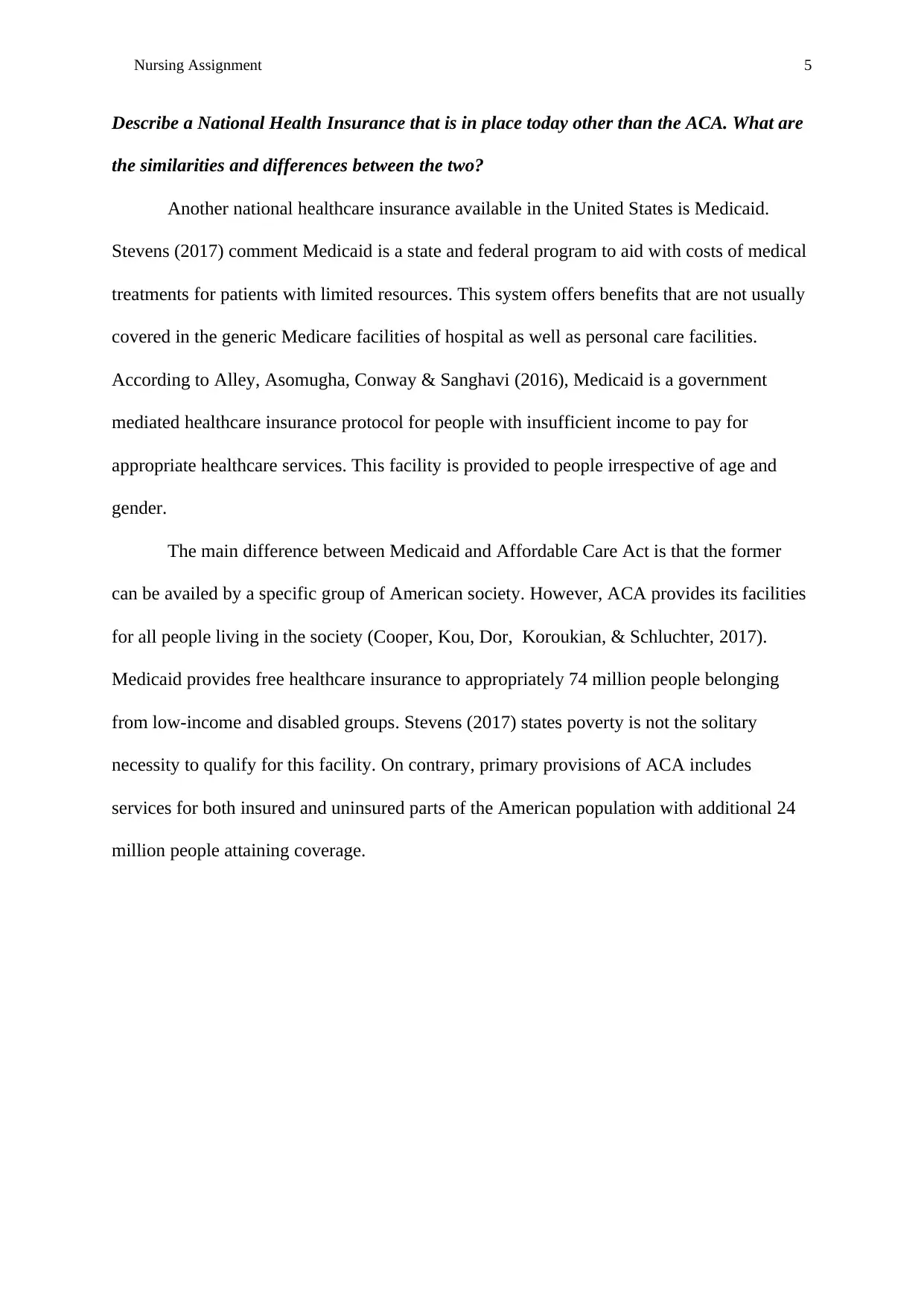
Nursing Assignment 5
Describe a National Health Insurance that is in place today other than the ACA. What are
the similarities and differences between the two?
Another national healthcare insurance available in the United States is Medicaid.
Stevens (2017) comment Medicaid is a state and federal program to aid with costs of medical
treatments for patients with limited resources. This system offers benefits that are not usually
covered in the generic Medicare facilities of hospital as well as personal care facilities.
According to Alley, Asomugha, Conway & Sanghavi (2016), Medicaid is a government
mediated healthcare insurance protocol for people with insufficient income to pay for
appropriate healthcare services. This facility is provided to people irrespective of age and
gender.
The main difference between Medicaid and Affordable Care Act is that the former
can be availed by a specific group of American society. However, ACA provides its facilities
for all people living in the society (Cooper, Kou, Dor, Koroukian, & Schluchter, 2017).
Medicaid provides free healthcare insurance to appropriately 74 million people belonging
from low-income and disabled groups. Stevens (2017) states poverty is not the solitary
necessity to qualify for this facility. On contrary, primary provisions of ACA includes
services for both insured and uninsured parts of the American population with additional 24
million people attaining coverage.
Describe a National Health Insurance that is in place today other than the ACA. What are
the similarities and differences between the two?
Another national healthcare insurance available in the United States is Medicaid.
Stevens (2017) comment Medicaid is a state and federal program to aid with costs of medical
treatments for patients with limited resources. This system offers benefits that are not usually
covered in the generic Medicare facilities of hospital as well as personal care facilities.
According to Alley, Asomugha, Conway & Sanghavi (2016), Medicaid is a government
mediated healthcare insurance protocol for people with insufficient income to pay for
appropriate healthcare services. This facility is provided to people irrespective of age and
gender.
The main difference between Medicaid and Affordable Care Act is that the former
can be availed by a specific group of American society. However, ACA provides its facilities
for all people living in the society (Cooper, Kou, Dor, Koroukian, & Schluchter, 2017).
Medicaid provides free healthcare insurance to appropriately 74 million people belonging
from low-income and disabled groups. Stevens (2017) states poverty is not the solitary
necessity to qualify for this facility. On contrary, primary provisions of ACA includes
services for both insured and uninsured parts of the American population with additional 24
million people attaining coverage.
⊘ This is a preview!⊘
Do you want full access?
Subscribe today to unlock all pages.

Trusted by 1+ million students worldwide
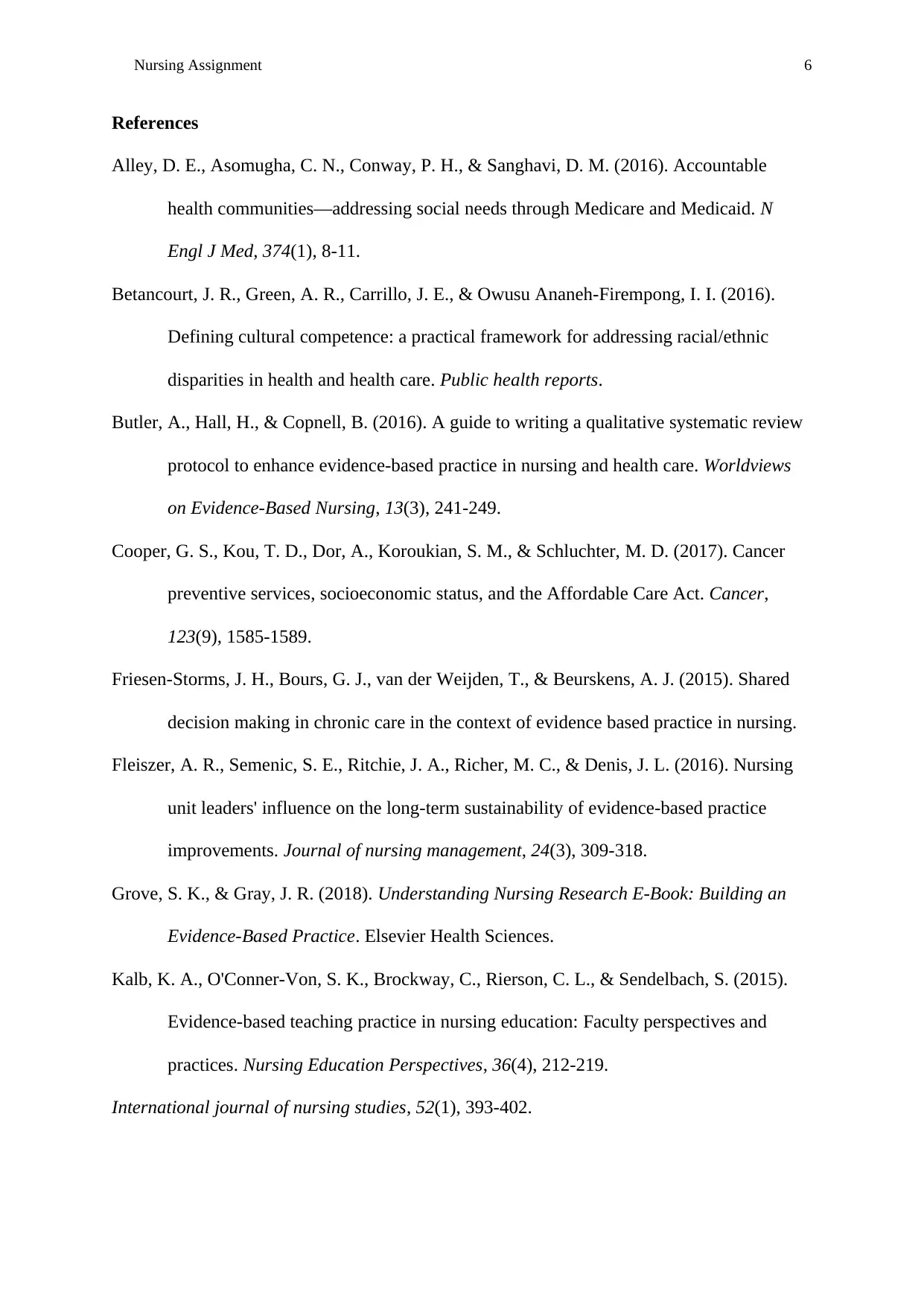
Nursing Assignment 6
References
Alley, D. E., Asomugha, C. N., Conway, P. H., & Sanghavi, D. M. (2016). Accountable
health communities—addressing social needs through Medicare and Medicaid. N
Engl J Med, 374(1), 8-11.
Betancourt, J. R., Green, A. R., Carrillo, J. E., & Owusu Ananeh-Firempong, I. I. (2016).
Defining cultural competence: a practical framework for addressing racial/ethnic
disparities in health and health care. Public health reports.
Butler, A., Hall, H., & Copnell, B. (2016). A guide to writing a qualitative systematic review
protocol to enhance evidence‐based practice in nursing and health care. Worldviews
on Evidence‐Based Nursing, 13(3), 241-249.
Cooper, G. S., Kou, T. D., Dor, A., Koroukian, S. M., & Schluchter, M. D. (2017). Cancer
preventive services, socioeconomic status, and the Affordable Care Act. Cancer,
123(9), 1585-1589.
Friesen-Storms, J. H., Bours, G. J., van der Weijden, T., & Beurskens, A. J. (2015). Shared
decision making in chronic care in the context of evidence based practice in nursing.
Fleiszer, A. R., Semenic, S. E., Ritchie, J. A., Richer, M. C., & Denis, J. L. (2016). Nursing
unit leaders' influence on the long‐term sustainability of evidence‐based practice
improvements. Journal of nursing management, 24(3), 309-318.
Grove, S. K., & Gray, J. R. (2018). Understanding Nursing Research E-Book: Building an
Evidence-Based Practice. Elsevier Health Sciences.
Kalb, K. A., O'Conner-Von, S. K., Brockway, C., Rierson, C. L., & Sendelbach, S. (2015).
Evidence-based teaching practice in nursing education: Faculty perspectives and
practices. Nursing Education Perspectives, 36(4), 212-219.
International journal of nursing studies, 52(1), 393-402.
References
Alley, D. E., Asomugha, C. N., Conway, P. H., & Sanghavi, D. M. (2016). Accountable
health communities—addressing social needs through Medicare and Medicaid. N
Engl J Med, 374(1), 8-11.
Betancourt, J. R., Green, A. R., Carrillo, J. E., & Owusu Ananeh-Firempong, I. I. (2016).
Defining cultural competence: a practical framework for addressing racial/ethnic
disparities in health and health care. Public health reports.
Butler, A., Hall, H., & Copnell, B. (2016). A guide to writing a qualitative systematic review
protocol to enhance evidence‐based practice in nursing and health care. Worldviews
on Evidence‐Based Nursing, 13(3), 241-249.
Cooper, G. S., Kou, T. D., Dor, A., Koroukian, S. M., & Schluchter, M. D. (2017). Cancer
preventive services, socioeconomic status, and the Affordable Care Act. Cancer,
123(9), 1585-1589.
Friesen-Storms, J. H., Bours, G. J., van der Weijden, T., & Beurskens, A. J. (2015). Shared
decision making in chronic care in the context of evidence based practice in nursing.
Fleiszer, A. R., Semenic, S. E., Ritchie, J. A., Richer, M. C., & Denis, J. L. (2016). Nursing
unit leaders' influence on the long‐term sustainability of evidence‐based practice
improvements. Journal of nursing management, 24(3), 309-318.
Grove, S. K., & Gray, J. R. (2018). Understanding Nursing Research E-Book: Building an
Evidence-Based Practice. Elsevier Health Sciences.
Kalb, K. A., O'Conner-Von, S. K., Brockway, C., Rierson, C. L., & Sendelbach, S. (2015).
Evidence-based teaching practice in nursing education: Faculty perspectives and
practices. Nursing Education Perspectives, 36(4), 212-219.
International journal of nursing studies, 52(1), 393-402.
Paraphrase This Document
Need a fresh take? Get an instant paraphrase of this document with our AI Paraphraser
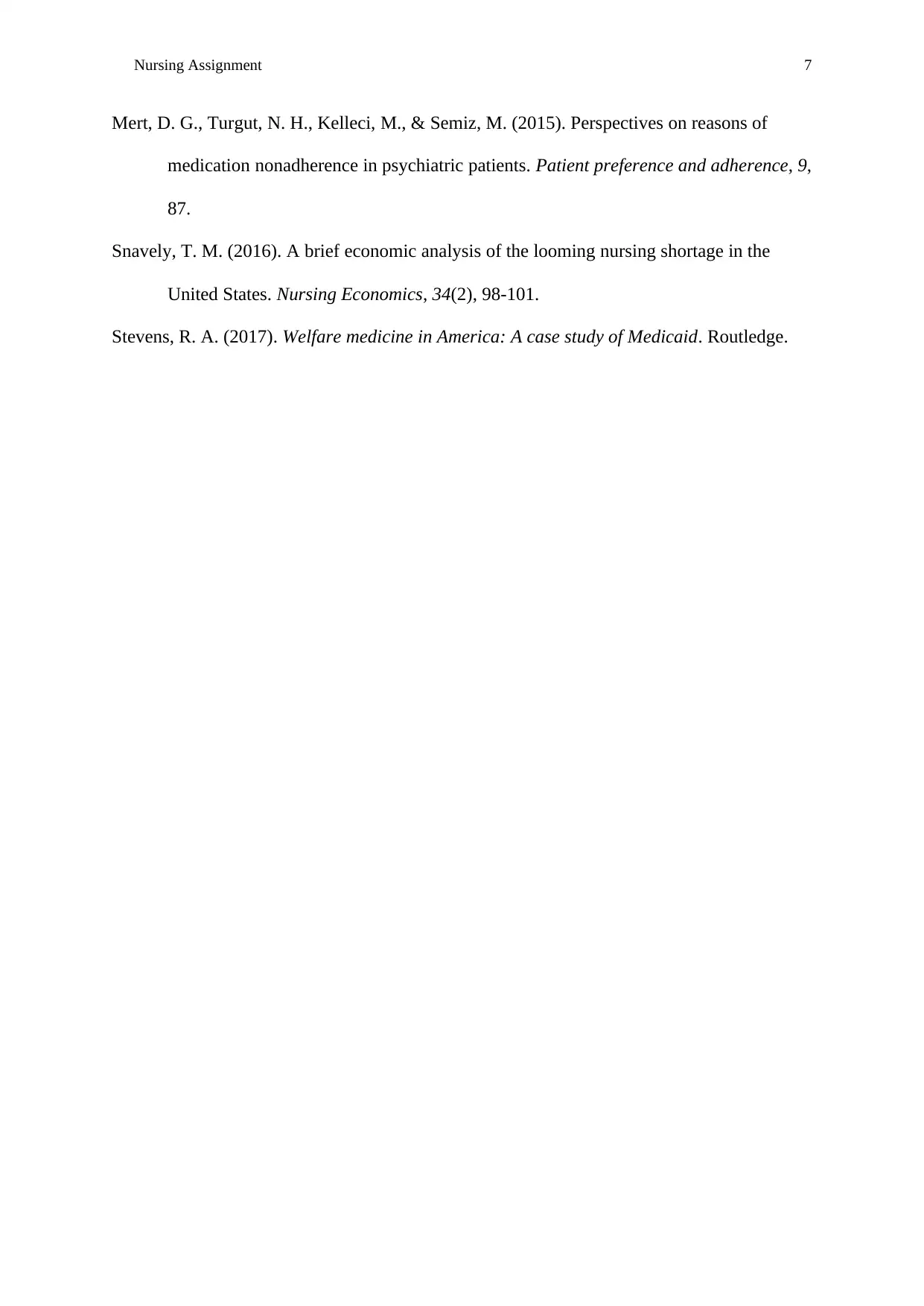
Nursing Assignment 7
Mert, D. G., Turgut, N. H., Kelleci, M., & Semiz, M. (2015). Perspectives on reasons of
medication nonadherence in psychiatric patients. Patient preference and adherence, 9,
87.
Snavely, T. M. (2016). A brief economic analysis of the looming nursing shortage in the
United States. Nursing Economics, 34(2), 98-101.
Stevens, R. A. (2017). Welfare medicine in America: A case study of Medicaid. Routledge.
Mert, D. G., Turgut, N. H., Kelleci, M., & Semiz, M. (2015). Perspectives on reasons of
medication nonadherence in psychiatric patients. Patient preference and adherence, 9,
87.
Snavely, T. M. (2016). A brief economic analysis of the looming nursing shortage in the
United States. Nursing Economics, 34(2), 98-101.
Stevens, R. A. (2017). Welfare medicine in America: A case study of Medicaid. Routledge.
1 out of 8
Related Documents
Your All-in-One AI-Powered Toolkit for Academic Success.
+13062052269
info@desklib.com
Available 24*7 on WhatsApp / Email
![[object Object]](/_next/static/media/star-bottom.7253800d.svg)
Unlock your academic potential
Copyright © 2020–2025 A2Z Services. All Rights Reserved. Developed and managed by ZUCOL.




